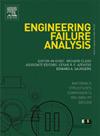功能分级UHPFRC-HSC梁抗弯性能试验与数值研究
IF 5.7
2区 工程技术
Q1 ENGINEERING, MECHANICAL
引用次数: 0
摘要
对超高性能纤维混凝土(UHPFRC)配高强混凝土(HSC)的功能级配钢筋混凝土(FGRC)梁的抗弯性能进行了试验和数值研究。10根简支梁进行四点弯曲试验,采用两种不同的纵向拉伸配筋率(ρl)来表示低和高比率。FGRC梁的抗压强度为157.2 MPa的UHPFRC和76.8 MPa的HSC。UHPFRC层被策略性地放置在压缩和拉伸区或仅在梁的压缩区。实验结果表明,FGRC梁具有与UHPFRC基准梁相当的延性和强度,但成本要低得多。上层和下层均有UHPFRC层的FGRC梁占梁高的40%,高配筋率(ρl = 4.0%)的FGRC梁的延性比HSC基准梁高261.6%。它的抗弯承载力是纯UHPFRC梁的91.6%。当UHPFRC层数占梁高的66.7%时,FGRC梁的延性显著提高,与HSC参考梁相比,延性达到286.3%,能够承载UHPFRC梁的96.9%的荷载能力。将试验梁的ρl从1.38%提高到4.0%,显著提高了梁的抗弯强度,同时保持了良好的延性。设计规范提供了保守的抗弯强度估计,而AFGC-2013、JSCE-2008和KCI-2012的截面分析则准确地预测了FGRC梁的强度。该数值模型与简支UHPFRC-HSC梁的试验结果吻合较好。本文章由计算机程序翻译,如有差异,请以英文原文为准。
Experimental and numerical study on flexural behavior of functionally graded UHPFRC-HSC beams
The flexural behavior of Functionally Graded Reinforced Concrete (FGRC) beams using Ultra-High Performance Fiber Reinforced Concrete (UHPFRC) with High-Strength Concrete (HSC) was investigated experimentally and numerically. Ten simply supported beams were subjected to four-point bending tests, with two varying ratios of longitudinal tensile reinforcement (ρl), to represent low and high ratios. The FGRC beams incorporate UHPFRC with a compressive strength of 157.2 MPa and HSC with 76.8 MPa. The UHPFRC layer was strategically placed in either the compression and tension zones or only in the compression zone of the beam. Experimental findings showed that FGRC beams demonstrated comparable ductility and strength to UHPFRC reference beams but at a much lower cost. FGRC beams with layers of UHPFRC on both the upper and lower layers, which make up 40 % of the total beam height, a beam with a high reinforcement ratio (ρl = 4.0 %) exhibited ductility of 261.6 % compared to HSC reference beam. It also carried 91.6 % of the flexural capacity of the pure UHPFRC beam. When the layers of UHPFRC accounted for 66.7 % of the beam’s height, the FGRC beams showed a notable increase in ductility, reaching 286.3 % compared to the HSC reference beam, and were able to carry 96.9 % of the load capacity of the UHPFRC beam. Raising ρl from 1.38 % to 4.0 % in the tested beams significantly improved flexural strength while maintaining good ductility. Design codes provided conservative flexural strength estimates, while sectional analysis per AFGC-2013, JSCE-2008, and KCI-2012 accurately predicted FGRC beam strength. The proposed numerical model showed a significant alignment with the test results of the simply supported UHPFRC-HSC beams.
求助全文
通过发布文献求助,成功后即可免费获取论文全文。
去求助
来源期刊

Engineering Failure Analysis
工程技术-材料科学:表征与测试
CiteScore
7.70
自引率
20.00%
发文量
956
审稿时长
47 days
期刊介绍:
Engineering Failure Analysis publishes research papers describing the analysis of engineering failures and related studies.
Papers relating to the structure, properties and behaviour of engineering materials are encouraged, particularly those which also involve the detailed application of materials parameters to problems in engineering structures, components and design. In addition to the area of materials engineering, the interacting fields of mechanical, manufacturing, aeronautical, civil, chemical, corrosion and design engineering are considered relevant. Activity should be directed at analysing engineering failures and carrying out research to help reduce the incidences of failures and to extend the operating horizons of engineering materials.
Emphasis is placed on the mechanical properties of materials and their behaviour when influenced by structure, process and environment. Metallic, polymeric, ceramic and natural materials are all included and the application of these materials to real engineering situations should be emphasised. The use of a case-study based approach is also encouraged.
Engineering Failure Analysis provides essential reference material and critical feedback into the design process thereby contributing to the prevention of engineering failures in the future. All submissions will be subject to peer review from leading experts in the field.
 求助内容:
求助内容: 应助结果提醒方式:
应助结果提醒方式:


